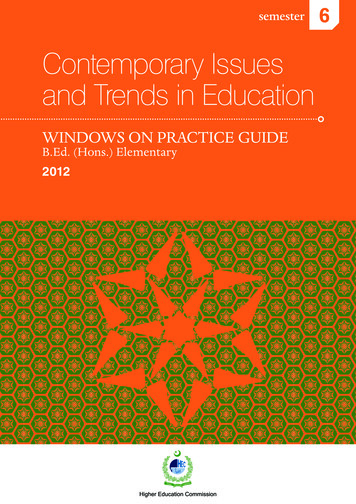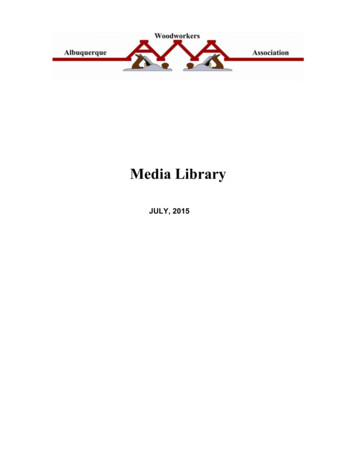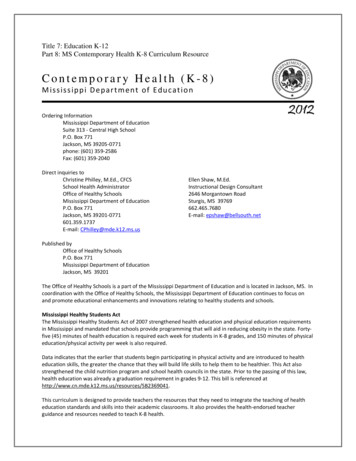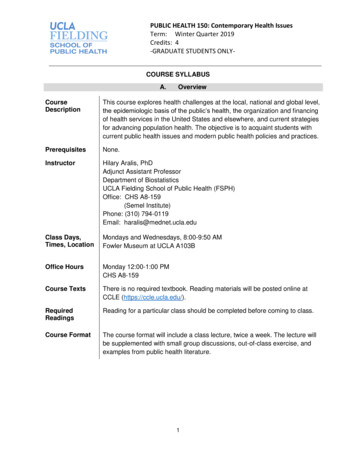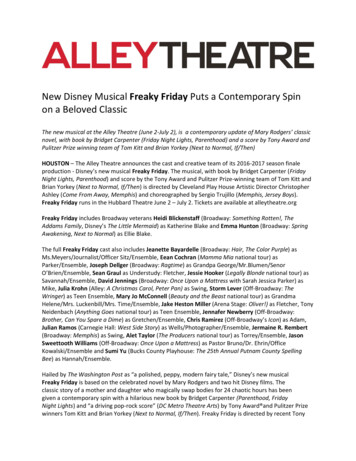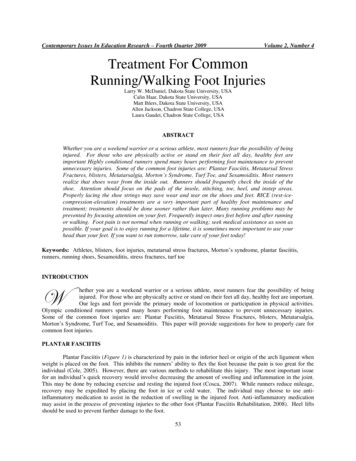
Transcription
Contemporary Issues In Education Research – Fourth Quarter 2009Volume 2, Number 4Treatment For CommonRunning/Walking Foot InjuriesLarry W. McDaniel, Dakota State University, USACalin Haar, Dakota State University, USAMatt Ihlers, Dakota State University, USAAllen Jackson, Chadron State College, USALaura Gaudet, Chadron State College, USAABSTRACTWhether you are a weekend warrior or a serious athlete, most runners fear the possibility of beinginjured. For those who are physically active or stand on their feet all day, healthy feet areimportant Highly conditioned runners spend many hours performing foot maintenance to preventunnecessary injuries. Some of the common foot injuries are: Plantar Fasciitis, Metatarsal StressFractures, blisters, Metatarsalgia, Morton’s Syndrome, Turf Toe, and Sesamoiditis. Most runnersrealize that shoes wear from the inside out. Runners should frequently check the inside of theshoe. Attention should focus on the pads of the insole, stitching, toe, heel, and instep areas.Properly lacing the shoe strings may save wear and tear on the shoes and feet. RICE (rest-icecompression-elevation) treatments are a very important part of healthy foot maintenance andtreatment; treatments should be done sooner rather than later. Many running problems may beprevented by focusing attention on your feet. Frequently inspect ones feet before and after runningor walking. Foot pain is not normal when running or walking; seek medical assistance as soon aspossible. If your goal is to enjoy running for a lifetime, it is sometimes more important to use yourhead than your feet. If you want to run tomorrow, take care of your feet today!Keywords: Athletes, blisters, foot injuries, metatarsal stress fractures, Morton’s syndrome, plantar fasciitis,runners, running shoes, Sesamoiditis, stress fractures, turf toeINTRODUCTIONWhether you are a weekend warrior or a serious athlete, most runners fear the possibility of beinginjured. For those who are physically active or stand on their feet all day, healthy feet are important.Our legs and feet provide the primary mode of locomotion or participation in physical activities.Olympic conditioned runners spend many hours performing foot maintenance to prevent unnecessary injuries.Some of the common foot injuries are: Plantar Fasciitis, Metatarsal Stress Fractures, blisters, Metatarsalgia,Morton’s Syndrome, Turf Toe, and Sesamoiditis. This paper will provide suggestions for how to properly care forcommon foot injuries.PLANTAR FASCIITISPlantar Fasciitis (Figure 1) is characterized by pain in the inferior heel or origin of the arch ligament whenweight is placed on the foot. This inhibits the runners’ ability to flex the foot because the pain is too great for theindividual (Cole, 2005). However, there are various methods to rehabilitate this injury. The most important issuefor an individual’s quick recovery would involve decreasing the amount of swelling and inflammation in the joint.This may be done by reducing exercise and resting the injured foot (Cosca, 2007). While runners reduce mileage,recovery may be expedited by placing the foot in ice or cold water. The individual may choose to use antiinflammatory medication to assist in the reduction of swelling in the injured foot. Anti-inflammatory medicationmay assist in the process of preventing injuries to the other foot (Plantar Fasciitis Rehabilitation, 2008). Heel liftsshould be used to prevent further damage to the foot.53
Contemporary Issues In Education Research – Fourth Quarter 2009Volume 2, Number 4Figure 1 (National Library of Medicine, 2006)Since the runner developed Plantar Fasciitis in one foot, the other foot may be susceptible to the sameinjury. The injured person should stretch each foot by dorsi flexing (moving the foot towards the tibia and fibula)both feet at the same time. This process should be followed by alternating one foot at a time Rehabilitation therapyincludes plantar flexing both feet (heel raises) using a towel to assist in the process of stretching the Achilles tendon.To increase muscular strength and muscular endurance to the injured area swimming, running in the water, or usinga stationary bike is recommended (Cole, 2005). The above recommended exercises increase muscular activity inboth the foot and calf muscles.METATARSAL STRESS FRACTURESMetatarsal Stress Fractures (Figure 2) are caused by overuse of the foot. The treatment for these injuriesreduces the amount of activity and pressure on the injured foot. Since this is a fracture of one of the metatarsalbones, walking or jogging will cause pain (Cohen 2007). In some cases crutches and wearing a protective boot willreduce pressure on the metatarsals. Biking is recommended to maintain strength and endurance in the lower body,because it places less pressure on the metatarsal bones and increased blood flow may expedite healing. The healingprocess usually takes from 3–12 weeks in order for the individual to fully recover.Figure 2 (Value Brace, 2008)BLISTERSBlisters (Figure 3) are generated by constant friction against the skin, which causes a fluid filled pocket toform on the affected area. Blisters are the most common injury among runners, athletes, and others who exercise.54
Contemporary Issues In Education Research – Fourth Quarter 2009Volume 2, Number 4Blisters are caused by shoes that are not built just for ones feet, but are mass produced. Most people do not take theproper time to break in their shoes correctly (Mitnick, 2008). In early blister formation, pain relief may occur byremoving the shoe to allow the area to cool down. The runner may cover the area to help reduce the friction on thefoot. Second skin, tape, and other forms of bandages may be applied to help protect the blister from becoming worse(Mitnick). After a blister has formed, the runner should decide if it makes walking painful. If the blister does notinhibit walking, then the blister should be allowed to heal on its own. The runner may use a form of second skin tohelp prevent the blister from getting worse. If the blister has reached a point where it hurts while one is walking anddoing daily activities, then it is recommended to puncture the blister and allow the excess fluid to drain (Mitnick,2008). The runner should not remove the skin of the blister, because by doing so the blister may become infected.Figure 3 (Relags, 2008)METATARSALGIAMetatarsalgia (Figure 4) is mainly caused by the shape of your foot. The reason that the shape of the footcauses Metatarsalgia is unclear, but researchers and therapists know how to reduce the incidences of Metatarsalgia.This is an easy injury to take care of as it is localized in the metatarsal joints that are inflamed and causing pain.Since this condition involves inflamed joints, the best advice would be to rest the foot, ice, and take pain medicationthat reduces inflammation (Cohen, 2007). Other treatments to prevent Metatarsalgia from occurring are to changerunning shoes and increase padding. Shoe inserts may also be used to relieve pressure on the metatarsals (Cohen,2007). If discomfort in the foot still exists, it may be necessary to consult their local physical therapist for otheroptions such as ultrasound, a form of deep heat, to help fight off the pain and inflammation.Figure 4 (Try Care, 2008)MORTON’S SYNDROMEMorton’s Syndrome (Figure 5) is the inflammation of a nerve found between the third and fourthmetatarsal which produces pain in the toes (Cosca 2007). This condition may cause the inability to move the toes.Treatment for this injury varies with the degree of severity. Surgery for Morton’s Syndrome is a last resort55
Contemporary Issues In Education Research – Fourth Quarter 2009Volume 2, Number 4(Morton’s Neuroma, 2008). Therapists are recommended to experiment with various forms of therapy andtechniques to assist individuals in the process of recovering from Morton’s syndrome. These techniques includehaving the patient change the type of shoe wear, purchase shoe inserts to increase the padding in the shoe, or themedical specialist may prescribe orthodics. Orthodics relieves the pressure on the inflamed nerve (Morton’sNeuroma, 2008). Another form of therapy involves icing the foot and taking non-steroidal anti-inflammatorydrugs. These chemicals decrease the swelling of the nerve in the foot.Figure 5 (Google 2008)TURF TOETurf toe (Figure 6) occurs when the great toe is severely hyper-extended. This is a sprain of themetatarsophalangeal joint. Therapy related to Turf Toe includes rest, ice on the injured foot, and the use of crutchesto keep pressure off the foot (Edell, 2006). To maintain strength and increase circulation, in the injured area, manyexperts recommend the use of an exercise bike. If the individual’s goal is to increase overall strength, he or sheshould perform exercises that do not involve pressure on the injured toe. This pressure will cause more damage tothe toe. To relieve pain and allow the injured athlete to begin running, the toe may be strapped with tape to decreaseflexion in the range movement of the injured toe (Edell, 2006).Figure 6 (Edell 2008)SESAMOIDITISSesamoiditis is an inflammation of the Sesamoid bones and joints which are located near the great toe(Cosca 2007). The injured runner will have difficulty flexing or bending their great toe. In some cases if the injuryis severe the Sesamoid bones may be fractured (Sesamoid Fracture, 2008). Surgery related to this type of injury israre; however, in some cases surgery may be the primary method to expedite recovery. To reduce pain andinflammation in the great toe, it is important to rest the foot, take over-the-counter pain medication, and apply ice tothe injured area. During recover it may be beneficial to wear low healed shoes that have extra padding (SesamoidFracture, 2008). Tape is often used to immobilize the Great Toe which decreases recovery time. Rest and ice may56
Contemporary Issues In Education Research – Fourth Quarter 2009Volume 2, Number 4be the most important therapeutic modality. Sesamoiditis injuries may have a huge impact on runners. Hopefullyafter reading this information, runners will be able recognize common runner’s injuries and seek properly carebefore the injuries become to severe.Figure 7 (Aertex World Wide, 2008)SUMMARYThe purpose of this article was to share with others some of the ways common foot injuries may be treated.Most runners realize that shoes wear from the inside out. Runners should frequently check the inside of the shoe.Attention should focus on the pads of the insole, stitching, toe, heel, and instep areas. Properly lacing the shoestrings may save wear and tear on the shoes and the runner’s feet. Runners should start lacing with the eyeletsclosest to the toe and individually lace each set of eyelets all the way up until the shoe strings are tied. RICE (restice-compression-elevation) treatments are a very important part of healthy foot maintenance and treatment;treatments should be done sooner rather than later. Many running problems may be prevented by focusing attentionto your feet. Frequently inspect ones feet before and after running or walking. Foot pain is not normal when runningor walking; seek medical assistance as soon as possible. If your goal is to enjoy running for a lifetime, it issometimes more important to use your head than your feet. If you want to run tomorrow, take care of your feettoday!AUTHOR INFORMATIONLarry W. McDaniel, Ed.D. is an Associate Professor of Exercise Science at Dakota State University Madison, SD.USA. Dr. McDaniel was a First Team All-American football player (USA Football), a Hall of Fame Athlete, andHall of Fame Wrestling Coach.Allen Jackson, M. Ed., is an Assistant Professor of Physical Education and Health at Chadron State College inChadron, Nebraska (USA) who is well known for his presentations & publications at international conferencesfocusing on Leadership, Curriculum, and Health.Dr. Laura Gaudet, Ph.D., is a Professor and Chair of the Department of Counseling, Psychology and Social Workat Chadron State College, Chadron NE. She is well known for her publications and presentations at internationalconferences focusing on various topics in the field of psychology.Matt Ihlers & Calin Haar ware outstanding student enrolled at Dakota State University. Their goal is to somedaywork as a physical therapist or athletic training.57
Contemporary Issues In Education Research – Fourth Quarter 2009Volume 2, Number Aids for Metarsalgia [Photograph found in Try Care]. (n.d.). Retrieved December 21, 2008, /mometpad.gifAids for Morton's Syndrome [Photograph]. (n.d.). Retrieved December 21, 2008, jpgCohen, J. (2007, September 6). Metatarsalgia - Causes, Symptoms, and Treatment Methods. ArticleBASETechnologies, LLC. Retrieved December 21, 2008, from http://www.articlebase.comCole, C., Seto, C., & Gazewood, J. (2005). Plantar Fasciitis: Evidence-Based Review of Diagnosis andTherapy. American Family Physician, 72(11), 2237-2243. Retrieved December 21, 2008, from Proquest.Cosca, D. (2007). Common Problems in Endurance Athletes. American Family Physician, 76(2), 237-246.Retrieved December 21, 2008, from www.aafp.org/afpEdell, D. (2006, April 6). Turf - Toe. The Athletic Advisor. Retrieved December 21, 2008, fromhttp://www.athleticadvisor.comEdell, D. (2006, June 4). Turf - Toe Taping [Photograph]. Athletic Advisor. Retrieved December 21, 2008,from kle/turf-toe taping.htmFoot Boot [Photograph found in Value Brace]. (n.d.). Retrieved December 21, 2008, edtherapieslowtopwalker%5B1%5D.jpgMetatarsal Stress Fracture. (2005, November). Merck & Co., Inc. Retrieved December 21, 2008, fromhttp://www.merck.comMitnick, M. (n.d.). How to Treat a Foot Blister. WikiHow - The How-to Manual That You Can Edit.Retrieved December 21, 2008, from http://www.wikihow.com/Morton's Neuroma. (2008). Healthy Feet for an Active Life - FootPhysicians.com. Retrieved December 23,2008, from http://www.footphysicians.comPlantar Fasciitis [Photograph found in U.S. National Library of Medicine, Bethseda, MD]. (2006,September 21). Retrieved December 21, 2008, /ency/fullsize/19568.jpgPlantar Fasciitis Rehabilitation. (2008). UPMC Sports Medicine, UPMC University of Pittsburgh MedicalCenter, Pittsburgh, PA USA. Retrieved December 21, 2008, from http://sportsmedicine.upmc.comRelief to Sesamoiditis [Photograph found in Aetrex Worldwide, Inc.]. (n.d.). Retrieved December 21, 2008,from .gifSecond Skin [Photograph found in Relags]. (n.d.). Retrieved December 21, 2008, 0600 1.jpgSesamoid Fracture and Sesamoiditis. (2008). IHealthSpot. Retrieved December 21, 2008, fromhttp://www.iHealthSpot.com58
Running/Walking Foot Injuries Larry W. McDaniel, Dakota State University, USA Calin Haar, Dakota State University, USA . Olympic conditioned runners spend many hours performing foot maintenance to prevent unnecessary injuries. Some of the common foot injuries are: Plantar Fasciitis, Metatarsal Stress Fractures, blisters, Metatarsalgia .

